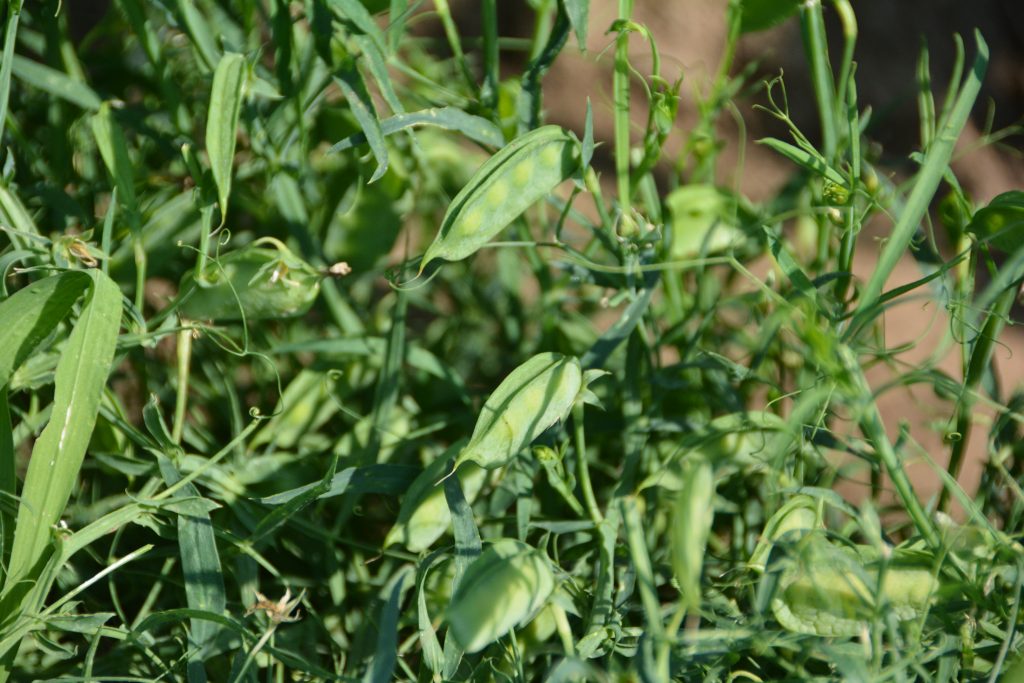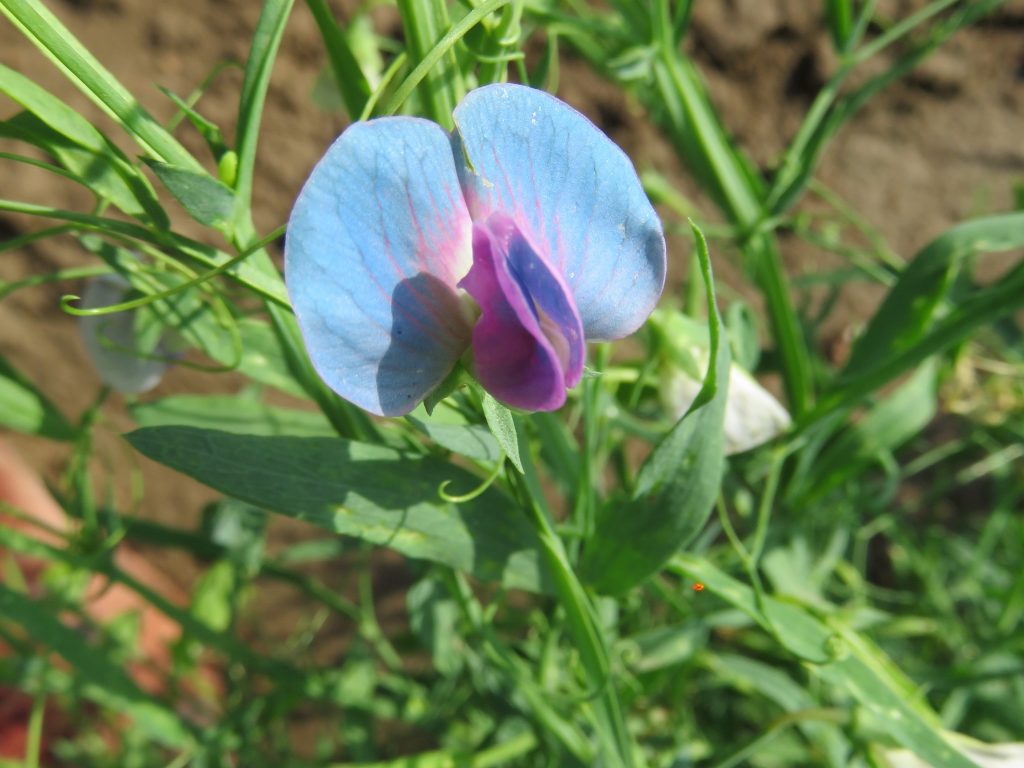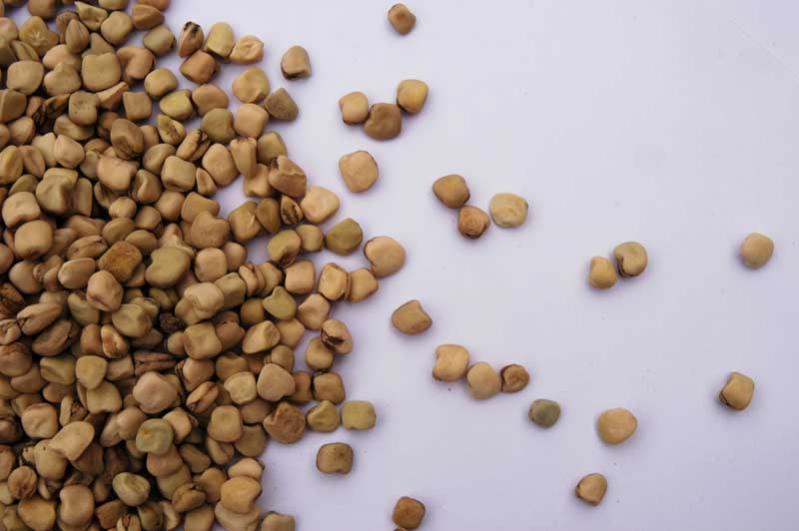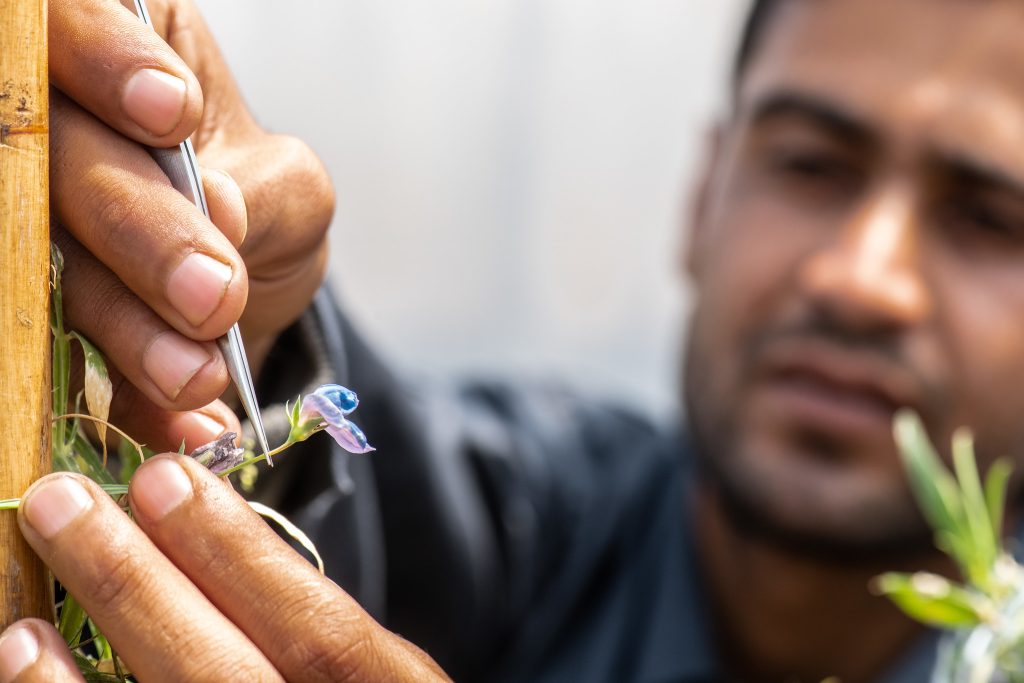Grass Pea (Lathyrus sativus)
Patricia Henderson
Colorado State University, Fort Collins, Colorado 80523
Corresponding author: patricia.henderson@colostate.edu; patrick.byrne@colostate.edu
OUTLINE
- Overview
- History
- Production and use
- Conservation and breeding
- Neurolathyrism
- References
- Chapter information
1. OVERVIEW

Lathyrus sativus, commonly referred to as grass pea, is a hardy legume with significant nutritional and stress-adaptive traits. Grass peas are well suited to a range of climate and soil types and can thrive in both dry and waterlogged conditions. While underutilized, this species has gained attention recently due to its tolerance of a variety of abiotic stresses. Lathyrus sativus plants are short, bushy diploid annuals (2n=14), with blue, pink, or white flowers and green seedpods. Their seedpods are curved and flat and contain 3 to 5 white or grey-brown seeds (Kumar et al., 2013).
To learn more about the importance of grass pea, check out this article and short video from Crop Trust.
2. HISTORY

As one of the earliest domesticated crops, grass peas unsurprisingly have a long history of cultivation. Seeds have been identified in Balkan excavations as early as 8000 BCE (Lambein et al., 2019). There are nearly 160 annual and perennial species within the genus Lathyrus that are distributed throughout temperate climates around the globe (Lambein et al., 2019). Kumar et al. (2013) provide a review of phylogenetic relationships among Lathyrus species.
Grass peas are most commonly found in Europe, South and West Asia, North Africa, and Ethiopia (Soren et al., 2015). There is some debate on the crop’s origin, some arguing that it stems from Central Asia, others indicating the Mediterranean region (Kumar et al., 2013). The exact origin of this plant is uncertain due to its long history of cultivation and the lack of marked differences in morphology between wild and domesticated populations. Likely, this overlap of wild and domestic types is due to the use of grass peas as both forage and grain legume crops within areas where it is native (Kumar et al., 2013). The crop’s spread across Europe, Africa, and South Asia occurred through migration and merchant trading primarily during the Bronze Age (roughly 3300 to 1200 BCE) (Kumar et al., 2013). Grass pea germplasm falls broadly into two groups, Asian and Mediterranean, having small and large seeds, respectively (Lambein et al., 2019).
3. PRODUCTION AND USE

While used mainly as food, forage, and livestock feed, grass pea can also be grown as an ornamental and used medicinally (Wiraguna et al., 2020). The most prominent grass pea production regions are in South Asia and East Africa, specifically Bangladesh, India, Pakistan, and Ethiopia (Lambein et al., 2019). Total production of grass pea is estimated at 1.2 million tons on 1.5 million hectares. Ethiopian production recently increased in total land area as well as amount harvested (Lambein et al., 2019). Bangladesh also followed this trend through the expansion of its total planted area in dry and flooded fields (Lambein et al., 2019). While still a production center, Europe has mostly de-emphasized grass peas in favor of better-known crops like chickpeas (Grela et al., 2010).
Grass peas are versatile in many ways through their ability to thrive in an extensive range of soil conditions, elevations, water levels, and other abiotic stresses (Lambein et al., 2019; Wiraguna et al., 2020). They are often grown as a summer crop in high altitudes as well as a winter crop at lower elevations (Lambein et al., 2019).
Grass peas are most prominent in arid and semiarid regions where more common legumes are not as well suited. Their ability to do well in low water conditions and their adaptability to poor-quality soils makes them extremely attractive to impoverished farmers. Their morphological adaptative mechanisms to drought conditions include narrow leaves, winged stems, and a deep root system (Lambein et al., 2019). Physiological adaptations include an elevated ability to adjust the plant’s osmotic potential and the upregulation of antioxidant enzyme genes (Lambein et al., 2019).
Waterlogging can be a problem in locations with monsoon climates. The influx of water into the soil blocks a root’s access to oxygen and can lead to a crop doing poorly if left in stagnant water for too long before the field can drain (Smartt et al., 1994). Farmers in Ethiopia use grass peas’ tolerance of this stress to their advantage, commonly growing it during their monsoon season in high clay-content soil prone to waterlogging (Wiraguna et al., 2020). This practice extends their growing season by several months on land that likely would not be used otherwise until after the monsoon season ends.
In terms of soil, grass peas are relatively undemanding and are good nitrogen fixers (Smartt et al., 1994). Grass peas have a high yield potential at low fertilization levels and hardy root systems that help them thrive in a broad range of soil types, from volcanic soils in Ethiopia to heavy clay soils in Bangladesh (Lambein et al., 2019; Grela et al., 2010). They are commonly used as an intercrop with wheat and rice, staple crops in the same regions (Lambein et al., 2019). They do very well in crop rotations due to their ability to improve soil conditions, reduce disease incidence, and lessen weed growth (Grela et al., 2010). All these qualities reduce its cost of production.
Grass peas are a popular food across several continents in a wide range of dishes. Many countries in Europe, Africa, and South Asia have numerous ways to prepare and eat them. Cooking, boiling, roasting, making them into drinks or sauces, and even eating uncooked seeds are all common ways for them to be consumed (Lambein et al., 2019). Grass pea seeds are remarkably high in protein, at a content level of about 27%, compared to chickpeas (Cicer arietinum), which commonly have only about 18% protein content (Wiraguna et al., 2020). They are also strong sources of starch, fiber, and secondary metabolites. (Soren et al., 2015). Because of this, a substantial portion of grass peas’ major production regions uses them as a primary protein supplement in their diets (Kumar et al., 2013). However, as in many grain legumes, grass pea is deficient in the sulfur-containing amino acids cystine and methionine (Lambein et al., 2019).
Grass peas are one of the hardiest but also most underutilized crops (Kumar et al., 2013). There are several reasons that help contribute to this underutilization, one of the main ones being an issue that can arise if grass peas are a population’s major source of protein for an extended period of time (Wiraguna et al., 2020). If grass peas are more than 20% of a diet’s protein content over a period of three consecutive months, it can lead to the development of a neurological disorder called ‘neurolathyrism’, due to the presence of the neuroexcitatory amino acid β-ODAP acid (Wiraguna et al., 2020). A stigma against grass peas has developed because of this, despite their significant dietary advantages and tolerance to abiotic stress.
4. CONSERVATION AND BREEDING

There are only limited grass pea resources in genebanks worldwide, and the genus Lathyrus is believed to have experienced serious genetic erosion in traditional growing areas in the past 50 years (Kumar et al., 2013). The largest collections of L. sativus accessions are in France (2382), the International Center for Agricultural Research in the Dry Areas (1627), Australia (572), and the USA (222) (Kumar et al., 2013). Overemphasis on the belief that excessive consumption of grass peas can lead to neurolathyrism has discouraged more collection, research, and use of this crop (Kumar et al., 2013). Another factor that explains the low level of scientific attention is its importance in resource-poor regions rather than primary agricultural areas (Soren et al., 2015). There is some genetic and genomic data available for this understudied crop, but the amount of data is low relative to other crops, partly because of its large, complex genome (8.2 Gb) (Lambein et al., 2019).
While grass peas have recently attracted interest due to their potential genetic role in addressing issues related to climate change, they still receive less attention than more prominent staple crops (Kumar et al., 2013). The conservation and continued sustainable use of its available genetic resources provide the best chance of improving our understanding of grass peas (Kumar et al., 2013). Breeding and evaluation objectives have included lower levels of β-ODAP, higher yield, appropriate phenology, and improved biotic and abiotic stress tolerance (Kumar et al., 2013; Lambein et al., 2019).
Even though it is not widely used, this crop remains attractive for its adaptability in the face of climate change and the growing severity and variability of growing seasons. Being tolerant to both a deficit and an excess of rainfall gives it the ability to grow in a variety of climates and helps ensure a food supply at locations with harsh environments (Soren et al., 2015). Because of these traits, it is a promising source of genes related to disease and abiotic stress tolerance that could be applied to breeding programs (Soren et al., 2015).
5. NEUROLATHYRISM
The overemphasis of grass peas’ toxic properties stems from ancient Greece and India, where the overconsumption of its seeds and the neurological disorder were linked (Lambein et al., 2019). This has led to it being disregarded and underutilized despite its very positive tolerances and nutritional advantages (Lambein et al., 2019). There are several studies looking into reducing the concentration of β-ODAP acid to make grass peas safer to eat. Neurolathyrism is usually inflicted only on those who are unable to secure other sources of protein (Smartt et al., 1994). In most current socioeconomic situations, when grass peas are eaten as part of a balanced diet, the development of this disorder is virtually non-existent (Lambein et al., 2019).
6. REFERENCES
Grela ER, Rybiński W, Klebaniuk R, Matras J. 2010. Morphological characteristics of some accessions of grass pea (Lathyrus sativus L.) grown in Europe and nutritional traits of their seeds. Genetic Resources and Crop Evolution 57:693-701. DOI: 10.1007/s10722-009-9505-4
Kumar S, Gupta P, Barpete S, Sarker A, Amri A, Mathur PN, Baum M. 2013. 11 – Grass pea. In Singh M, Upadhyaya HD, Bisht IS (eds.), Genetic and genomic resources of grain legume improvement. Elsevier Ltd. p. 269-292. DOI: 10.1016/B978-0-12-397935-3.00011-6
Lambein F, Travella S, Kuo YH, Van Montagu M, Heijde M. 2019. Grass pea (Lathyrus sativus L.): orphan crop, nutraceutical, or just plain food? Planta 250:821-838. DOI: 10.1007/s00425-018-03084-0
Smartt J, Kaul A, Amlak Araya W, Rahman MM, Kearney J. 1994. Grasspea (Lathyrus sativus L.) as a potentially safe legume food crop. In Expanding the Production and Use of Cool Season Food Legumes. Springer Netherlands. p. 144-155. DOI: 10.1007/978-94-011-0798-3_7
Soren KR, Yadav A, Pandey G, Gangwar P, Parihar AK, Bohra A, Dixit GP, Datta S, Singh NP. 2015. EST-SSR analysis provides insights about genetic relatedness, population structure and gene flow in grass pea (Lathyrus sativus). Plant Breeding 134:338-344. DOI: 10.1111/pbr.12268
Wiraguna E, Malik AI, Colmer TD, Erskine W. 2020. Waterlogging tolerance of grass pea (Lathyrus sativus L.) at germination related to country of origin. Experimental Agriculture 56:837-850. DOI: 10.1017/S0014479720000356
7. CHAPTER INFORMATION
Chapter citation: Henderson P. 2023. Grass Pea (Lathyrus sativus). In: Chen K, Byrne P (Eds.) Understudied Indigenous Crops. Fort Collins, Colorado: Colorado State University. Date accessed. Available from https://colostate.pressbooks.pub/understudiedindigenouscrops/chapter/grass-pea/
Chapter editor: Patrick Byrne

